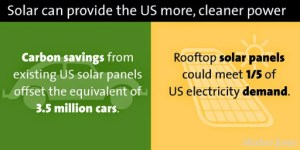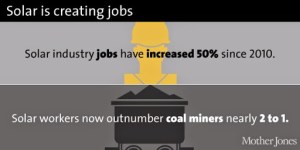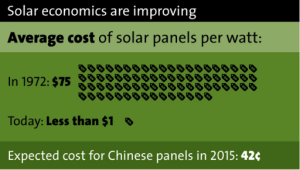Here comes the sun, Mother Jones, November 2014:
Last week, an energy analyst at Deutsche Bank came to a startling conclusion: By 2016, solar power will be as cheap or cheaper than electricity from the conventional grid in every state except three. That’s without any changes to existing policy.
In other words, we’re only a few years away from the point where, in most of the United States, there will be no economic reason not to go solar. If you care about slowing climate change or just moving toward cleaner energy, that is a huge deal.And solar energy is already going gangbusters… its potential is massive — it could power the [USA] 100 times over…
In the long run, free economies move to the lowest cost solutions. Without subsidies and publicly funded infrastructure, LNG from British Columbia is presently undeliverable and, as clean renewable energy becomes more cost-effective, industry demands for higher subsidies and other forms of relief will accelerate.
In time, with no profits to earn, foreigners will depart and remediation of wastes and contaminated lands will be an expense for the public. In the complete business cycle, from industry start-up to discontinuance, taxpayers will be the losers.
Addendum:
What gets left behind and who pays for cleanup?
- The Summitville Mine: Galactic Resources Ltd. of Canada, walked away from the site and filed for bankruptcy late in 1992, leaving behind acid mine drainage and a 160-million-gallon containment filled with cyanide-laden water that threatened to spill over the earthen berm holding it back…
- Tronox, Anadarko fight over cleanup costs may be just getting started: U.S. Bankruptcy Judge Allan Gropper held that Kerr-McGee acted with “intent to hinder” when it spun off what became Tronox in 2005, saying it was liable for between $5.15 billion and $14.17 billion in environmental cleanup…
- Taxpayers to pay for fracking pollution if companies go bust: Taxpayers will pay to clean up any pollution caused by fracking if the companies go bankrupt, after a proposal to make UK operators take out insurance against such damage was ruled out by the government…
- Supreme Court decision leaves taxpayers with the bill for cleaning up AbitibiBowater’s pollution: The Supreme Court decided that remediation orders, which required AbitibiBowater (now Resolute Forest Products) to clean up after years of pollution, are equivalent to private financial claims under insolvency law. The end result is that taxpayers will bear much of the financial and environmental costs associated with cleaning up Abitibi’s industrial sites.
- Sugar industry accused of dodging Everglades clean-up costs: Florida taxpayers have been left shouldering most of the $2 billion Everglades water pollution cleanup…
- Albertans risk having to clean up once the carnival leaves town: Oilsands mine reclamation liabilities in 2008 were estimated at up to $15 billion dollars — and the industry, along with the liabilities, has grown rapidly since…
- Canadian taxpayers on the hook for catastrophic oil spills from Enbridge Northern Gateway: Enbridge is not responsible for any of the costs associated with a spill once the oil is loaded onto tankers…
Categories: LNG








If Iran pays its citizens a subsidy to convert to using solar power, you know, a change is coming. The government of Iran provides a subsidy to all its citizens who purchase solar equipment and make the conversion. They obviously have seen the future and it is not in oil To bad our politicians can not see the future. perhaps it is because so many of their financial contributors live in the past
LikeLike
Forbes Magazine profile of Friedland:
“After losing control of his Ivanhoe Mines, founder and mining mogul Robert Friedland is showing international business mettle. In early 2012, mining group Rio Tinto took majority control of the company, forced Friedland to step down as CEO in April and change the firm's name to Turquoise Hill Resources in August. That didn't deter Friedland from holding a public offering for his Africa-based mining operation Ivanplats on the Toronto Stock Exchange in February, raising more than $300 million. Friedland is founder and chairman of Ivanplats (since renamed Ivanhoe MInes). Chicago native Friedland made his first fortune stumbling on a large nickel deposit at Voisey's Bay in Canada. He currently resides in Singapore and maintains dual American and Canadian citizenship.
His new company writes:
Robert Friedland is the founder of Ivanhoe Mines Ltd. (formerly Ivanplats Limited) …
Mr. Friedland was the founder of Ivanhoe Mines Ltd. (now Turquoise Hill Resources Ltd.) and served as Executive Chairman and Chief Executive Officer until April 2012. He directed the assembly by Ivanhoe Mines Ltd. of a portfolio of interests in several countries over 15 years and led the company's discoveries and initial development of the Oyu Tolgoi copper-gold-silver deposits in southern Mongolia.
Mr. Friedland also is Chairman and President of Ivanhoe Capital Corporation, a private company based in Singapore that specializes in providing venture capital and project financing for international business enterprises, predominantly in the fields of energy and minerals…
LikeLike
Isn't Ivanhoe and several other Freidland mines now 50% owned by Rio Tinto?
LikeLike
Okay, you'd think that Chrispy would finally get the massage (let the sun shine in) and go with Plan B. Except I don't believe she has a Plan B, and even if she did its apt to be more deluded than her Plan A.
So, why don't we make it easy for her. We have a glut of natural gas (as apparently does the rest of the world) Why not capitalize on that domestically: Ferries, trains, trucks & automobiles, What better way to offer a 'tax break' than reduce the cost of transportation and the goods (like food) that depend on it. Save the liquification costs, the transport costs, the environmental degradation. All those advertising costs, lawyers billable hours – the cost/savings are staggering.
She might even be able to reduce medical premiums to the pre-Liberal gouge fest days. AND SHE WOULD BE A HERO! Turning the LNG fiasco into a winning situation. She with the sparkly smile and bountiful cleavage could do it!
So, enough negativity. You and Grant have made your point exceedingly well over the years. Its time now to point her in the proper direction and make the best of a bad situation.
LikeLike
When Gordon Campbell and the Liberals forced BC Hydro to contract for fifty or sixty billion dollars of private power, the idea was to have a lucrative industry exporting power to California.
Private operators didn't want to carry any financial risk; they preferred taxpayers do that, in case the hoped-for export market did not materialize. So, instead of selling private power privately, the nascent industry sold it to the public at prices well above market rates and well above the average cost of BC Hydro's internal production.
In 2013, average wholesale prices for electricity in California were about half of what BC Hydro paid its private power suppliers so the chosen model was a great business decision for independent power producers. The premium cost to the public has been hundreds of millions, a number that will certainly rise into the billions.
LikeLike
72 percent of all residential solar projects in California were completed without any state incentives in the second quarter of 2014. California installers will deploy more than 1 gigawatt of residential and commercial projects this year, the majority completed without the help of the CSI incentives.
By 2018, California could be installing more than 2.5 gigawatts of residential and commercial systems with zero state incentives.
“Solar is still a really good deal for customers,” said Stewart, who has long since ceased applying for CSI incentives. Stewart did note that the federal Investment Tax Credit and net metering rules are still essential for making projects work in California, however.
How did California create a program with such a smooth phaseout?
The most important element, according to installers and program administrators, were volumetric reductions in incentives. Every time a certain number of megawatts was deployed, payments stepped down accordingly. That allowed the market to dictate incentive levels, instead of relying on lawmakers or an artificially imposed annual timeframe.
Even when utilities started running through their allotted CSI rebates — which fell to just a few hundred dollars per residential system last year — installers never slowed down. That's because solar companies were able to drop their costs and rely less on state subsidies as the market matured.
By contrast, Germany, the world's biggest solar market in terms of cumulative capacity, was slow to make legislative fixes to its feed-in tariff as the market exploded between 2010 and 2013. It is now dealing with billions of euros in yearly costs for contracts signed at the height of the boom.
Legacy of the California Solar Initiative
LikeLike
Good point about the “whoops” but the arguments here aim to avoid having the next generation saying that word when the final bill is calculated for polluting BC lands and water so that a few foreign energy companies can export natural gas without material payment or wide economic benefits.
B.C. could benefit far more by promoting renewable or inexhaustible energy sources like tidal, wave, geothermal, wind and solar.
LikeLike
Losses from burning fossil fuels, or from flooding arable lands or disrupting fish bearing riverways, have a greater probability than damages from utilizing solar energy. The US Dep't of Energy published Report on the Basic Energy Sciences Workshop, which includes this:
“World demand for energy is projected to more than double by 2050 and to more than triple by
the end of the century. Incremental improvements in existing energy networks will not be
adequate to supply this demand in a sustainable way. Finding sufficient supplies of clean energy
for the future is one of society’s most daunting challenges.
“Sunlight provides by far the largest of all carbon-neutral energy sources. More energy from
sunlight strikes the Earth in one hour (4.3 × 1020 J) than all the energy consumed on the planet in
a year (4.1 × 1020 J). We currently exploit this solar resource through solar electricity — a
$7.5 billion industry growing at a rate of 35–40% per annum — and solar-derived fuel from
biomass, which provides the primary energy source for over a billion people.
“Yet, in 2001, solar electricity provided less than 0.1% of the world's electricity, and solar fuel
from modern (sustainable) biomass provided less than 1.5% of the world's energy. The huge gap
between our present use of solar energy and its enormous undeveloped potential defines a grand
challenge in energy research. Sunlight is a compelling solution to our need for clean, abundant
sources of energy in the future. It is readily available, secure from geopolitical tension, and poses
no threat to our environment through pollution or to our climate through greenhouse gases.”
LikeLike
In August the Swiss bank, UBS, declared conventional power generation all but finished. It urged investors to get out of conventional power utilities and into solar instead. The bank claims that new technology could provide a 20-year home system, with battery technology, capable of handling all household needs and charging an electric car, that would pay for itself in 6 to 8-years for the average European customer.
http://www.theguardian.com/environment/2014/aug/27/ubs-investors-renewables-revolution
In Australia, where coal generation is big, there's been a huge shift to rooftop solar, residential and commercial, that has undercut the revenues and profits of conventional utilities.
LikeLike
I'm all for solar energy. I think it's probably the way of the future.
However, I think we should consider some of the downstream effects of converting to solar energy. In the past, all that energy has gone into heating the earth, growing vegetation, keeping the oceans at a temperature that can sustain aquatic life, and probably other things. If we now take the energy out of the ecosystem and use it to power cars, light our rooms, run our computers, etc. what effect does that have on the functioning of ecosystems?
If your statistics are correct, the effect will probably be minimal. But before we go headlong into solar power, shouldn't we (who is we? scientists?) think things through before we go “Whoops” 100 years down the road? We've made that mistake countless times in the past…we should start learning from past experiences.
LikeLike